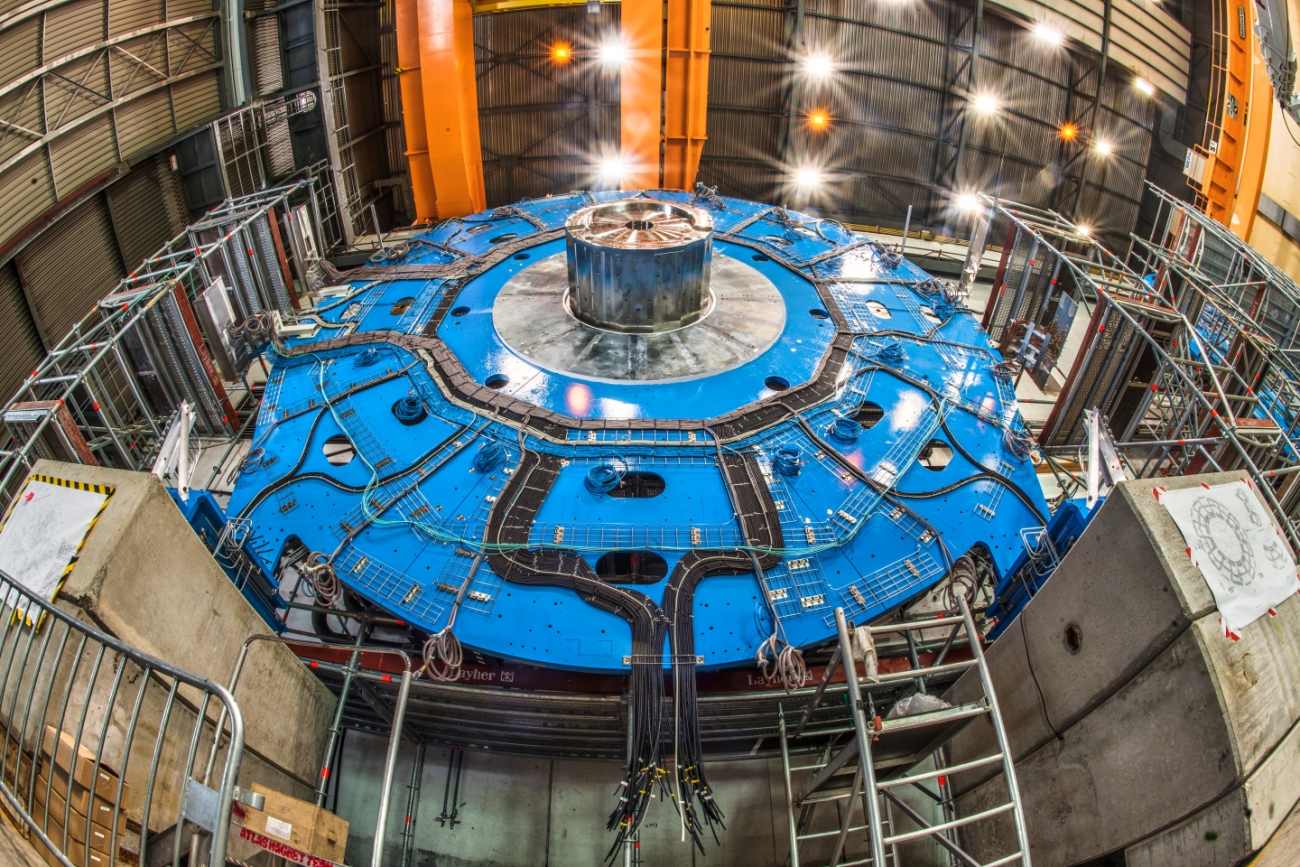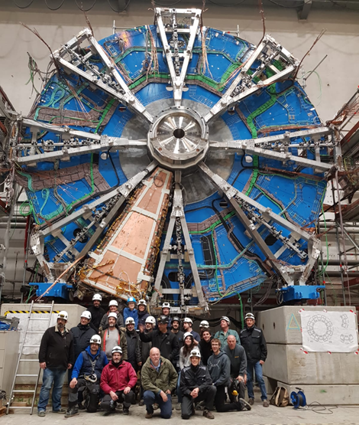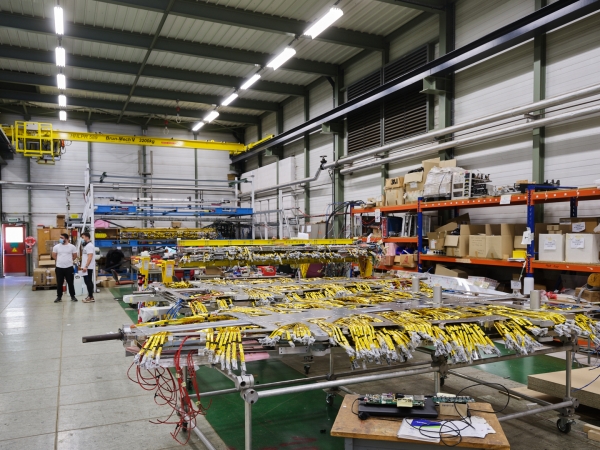ATLAS New Small Wheel Upgrade – activities resumed after down-time from COVID-19

As discussed in a previous issue of the EP Newsletter (The ATLAS New Small Upgrade – entering new waters, preparing to install and commission its first sector, October 2019), the New Small Wheel (NSW) Upgrade is the most challenging and complex one of the ATLAS phase-I upgrade projects.
As all the other upgrade projects for the LHC experiments, its goal is to prepare the detector for the High-Luminosity LHC era, and the unprecedented levels of pile up and background rates which one will have to cope with.

Figure 1: Wheel status first sector.
Work on the New Small Wheel at CERN had entered a new phase at the end of 2019, with the first complete sector been installed in building 191 on the NSW support structure, see Figure 1. The installation operation went extremely smooth, thanks also to the special handler-grabber-rotator tool that was custom-designed by a collaboration of engineers from the University of KwaZulu-Natal, South Africa, and ATLAS Technical Coordination. Following successful installation, the sector was surveyed, and its position adjusted and checked with the help of the NSW integrated alignment system. As soon as this operation was completed, the NSW services and commissioning crews connected it to its various services, including gas, cooling, low and high voltage power, readout fibers and trigger, and launched the commissioning process.
Here the overall strategy is that the pie shaped sTGC (small strip Thin Gap Chambers) and Micromegas wedges are already equipped with the electronics, and completely tested before they arrive in B191 for their assembly in the sector. The integration of Micromegas and sTGC chambers, into wedges, and the installation of the electronics also takes place at CERN, in buildings BB5 and B180, respectively. Nevertheless, unexpected loosening of connectors, leaks or similar anomalies can happen during the transportation and installation thus the commissioning protocol covers redoing a full readout test as well as HV and gas validation on each sector after installation. Moreover, the assembled sector installed on the NSW allows for the first time the trigger chain for the sTGC to be tested start-to-end, including the part of its electronics that sits on the NSW rim. It is also the first time that system aspects like electronics noise, interference or interplay between the Micromegas and sTGC or combined trigger operation of the two detector technologies can be studied and tested.
It is not unusual or unexpected that we met certain surprises during this activity with the first sector, notably an excessive level of electronics noise when operating with the final power supply. Intense investigations took place during January and the first weeks of February to find a solution. A second problem which had to be tackled was that the sTGC CO2 envelope was prone to developing cracks when the sector was manipulated. This envelope covers the sTGC detector wedges so that any flammable gas possibly leaking the active detector volume would be detected, diluted and sucked away and thus it is a critical element. Investigations into a refined sealing procedure started in January and February, and was successfully completed in July after resumption of the work due to the CERN COVID shutdown, with a lot of help from the EP/DT team and their expertise on sealants and glue products.
March saw the installation of the second sector, just before Europe was overwhelmed by the COVID-19 pandemic and CERN entered the safe-mode lockdown. While this obviously implied also the stop of any integration activities on the CERN site itself, the team has not been idle during the next months, but worked hard to refine commissioning tools, especially analysis software for the readout data, and significantly pushed ahead the firmware for the NSW trigger.
Once CERN re-opened, the ATLAS NSW activities were among the first ones resumed; in particular, electronics integration with the Micromegas and sTGC detector wedges went back to nominal operation within very few weeks after the official CERN restart date of May 18th.
Resuming the wedge assembly, i.e. the integration of the individual detector chambers into a wedge, and resuming sector installations and commissioning took somewhat longer. During the safe mode period, experts and collaborators had returned to their respective home institutes; in some cases institutes did not authorize (yet) their return to CERN. In other cases, people are from countries where the virus is still rampant, so that their place was under lockdown much longer than Switzerland or France. Finally, travel restrictions and border restrictions also necessitated extra formalities to be able to have people return.
It is with great pleasure though that as of July, all NSW activities are again ongoing here at CERN. Five more sectors have been installed since then, making the NSW look more and more like a real wheel (Figure 2). Building of wedges, both in building 180 for the sTGC and in BB5 for the Micromegas, is going at full speed, with the number of wedges worked on in parallel higher than ever (Figure 3 and 4).

Figure 2: Latest view of the NSW status in September 2020.


Figures 3 (top): BB5 MM integration and Figure 4 (bottom): sTGC integration in B180.
Also commissioning activities are once again in full swing, and a recent internal review showed that an updated completion date of spring 2021 for the first of the two NSWs (the one for side A) is realistic, and thus an installation into the ATLAS detector within LS2 is secured.
The situation is still less clear for NSW-C. ATLAS, also with the strong help from EP/DT and other CERN groups, strives to accelerate the integration and commissioning work such that the C-side NSW can be completed by October 1 2021. This date would make it possible to also install the second wheel still during LS2, based on the updated baseline schedule agreed between CERN’s management, the LHC machine and the experiments at the beginning of June.
Another internal review will take place mid October, to decide if this is indeed realistic. Suffice to say, while restarting the activities went very well, struggles and challenges are not over, and the NSW will keep the ATLAS Muon collaboration busy and engaged until the end of LS2, and also beyond when in operation.
